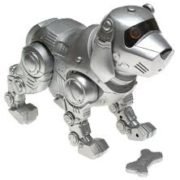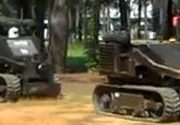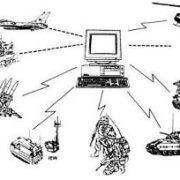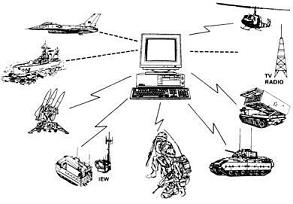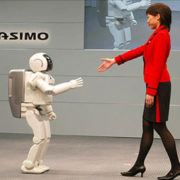Posts
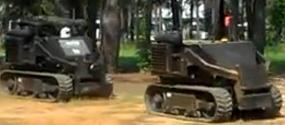 Wired.com took some videos of the action at the Robot Rodeo, including the autonomy demonstration, in which AMREL’s ROCKY DB6 played a major role. Video below.
Wired.com took some videos of the action at the Robot Rodeo, including the autonomy demonstration, in which AMREL’s ROCKY DB6 played a major role. Video below.
The ROCKY DB6, a Commercial-Off-The-Shelf (COTS) product, is the smallest, fully rugged handheld in the world that can run full Windows or Linux OS. DB6s acted as payload controllers and as an Operator Control Unit. Read more about its role as a platform for autonomous functions here.
At the recent Ground Robotics Capability Conference (GRCC), I surveyed a number of vendors about what was on their mind. I read them a list of topics that are frequently covered in OCU Pro newsletters as well as AMREL’s corporate blog.
By far, one topic elicited more interest than any other: interoperability. On one hand, I was pleased. AMREL has been a leader for developing solutions that have the ability to “… to work with or use the parts or equipment of another system” (Merriam-Webster definition). For example, our Flexpedient® Solutions enable kit building of Operator Control Units with common control capabilities.
 You can spot an AMREL laptop being used as an Operator Control Unit for a PackBot at about 59 seconds into this episode of NCIS: Los Angeles. For once, TV gives a relatively accurate depiction of how unmanned systems are actually used. Watch video.
You can spot an AMREL laptop being used as an Operator Control Unit for a PackBot at about 59 seconds into this episode of NCIS: Los Angeles. For once, TV gives a relatively accurate depiction of how unmanned systems are actually used. Watch video.
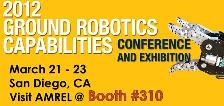 AMREL will once again be at the Ground Robotics Capabilities Conference (GRCC). GRCC is a big deal for us. At past GRCCs, we’ve launched Flexpedient ® Technology for interoperable Operator Control Unit solutions, introduced the interoperable payload controller, and showcased the DB6, the smallest fully rugged handheld in the world with Windows/Linux OS. This year, we are talking interoperability a step further with a line of complete Unmanned Subsystems solutions. If you want a sneak peek at these remarkable new solutions, drop by Booth 310, and ask if there are there any tickets left to AMREL’s exclusive Technology Suite. See you in San Diego!
AMREL will once again be at the Ground Robotics Capabilities Conference (GRCC). GRCC is a big deal for us. At past GRCCs, we’ve launched Flexpedient ® Technology for interoperable Operator Control Unit solutions, introduced the interoperable payload controller, and showcased the DB6, the smallest fully rugged handheld in the world with Windows/Linux OS. This year, we are talking interoperability a step further with a line of complete Unmanned Subsystems solutions. If you want a sneak peek at these remarkable new solutions, drop by Booth 310, and ask if there are there any tickets left to AMREL’s exclusive Technology Suite. See you in San Diego!
December Update If you are not reading The Robot Report (and you should be; it’s one of the best things on the web about the robotic industry), you may have missed their article about the Fukushima Daiichi disaster. Much of what it says will not be news to the readers of this blog, but one paragraph caught my attention:
“In the case of Fukushima, both iRobot and QinetiQ, companies that volunteered equipment to Tepco, instructors found that senior Tepco employees were chosen to be trained to operate the American and British robots yet they were less suited to the task than the 20-year olds who had gamer experience. The remote-controlled PackBot and Talon robots and the RC Bobcat tractors, all used gaming consoles to operate their devices and the senior employees were slow to learn. In a recent Webinar on the issue by Robotic Trends, the trainers found that 20-year olds learned in less than a day while it took the older Tepco employees many days to gain the same level of competence.”
With the recent rapid growth of unmanned systems, there has been much speculation about the disruptive effects of their wide-spread adoption. A commonly-held view is that low-skilled workers will be displaced, while an educated elite (presumably people who make robots) will continue to thrive. Read more
 Recently, some clients asked AMREL to build an Operator Control Unit (OCU) for their Unmanned Ground Vehicle. No surprise there; we dominate that particular application. What was noteworthy was the specific form factor that they requested. They wanted it to be a wearable computer, worn on the wrist.
Recently, some clients asked AMREL to build an Operator Control Unit (OCU) for their Unmanned Ground Vehicle. No surprise there; we dominate that particular application. What was noteworthy was the specific form factor that they requested. They wanted it to be a wearable computer, worn on the wrist.
We ran a simple experiment with the clients. We strapped a small computer to their wrist and had them run some typical UGV commands. Soon, they discovered that their arms grew tired supporting the computer. The clients agreed to have their OCU installed in the traditional, if less exotic, form factor of a handheld.
Notice that the wrist-mounted form factor wasn’t discarded for technological reasons. AMREL has become quite adept at developing small, powerful, ATOM-based computer platforms, which would be perfect for wearable solutions. Rather, this innovative approach was discarded, because the wrist form factor proved impractical for this particular use. Read more
American Reliance, Inc.
789 N Fair Oaks Ave,
Pasadena, CA 91103
Office Hours
Monday-Friday:
8:00 am – 5:00 pm PST
Saturday: Closed
Sunday: Closed
Main: +1 (626) 482-1862
Fax: +1 (626) 226-5716
Email: AskUs@amrel.com
Blog Posts
Mobile Biometric Solutions
Mobile Biometric Smartphones & Tablets
BioFlex S® Commercial Smartphones
BioSense AT80B | 8″ Android Biometric Tablet
BioSense PA5 | 10.1″ (Gen 2) Android Biometric Tablet
BioSense PA5 | 10.1″ Android Biometric Tablet
BIOPTIX PM3B | 7″ Windows Biometric Tablet
BIOPTIX PM5B | 10.1″ Windows Biometric Atom Tablet

